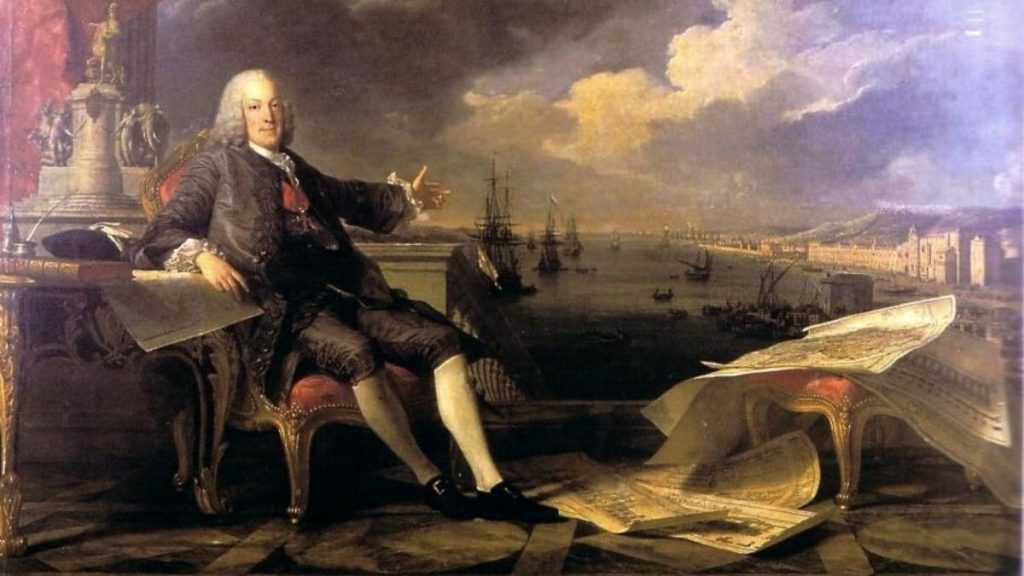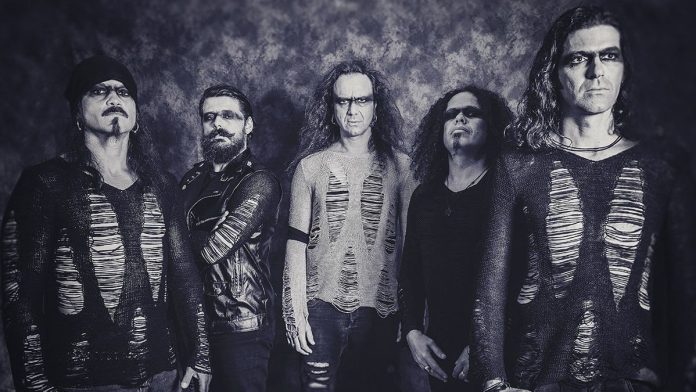When Fernando Ribeiro describes his band’s 2017 concept album 1755, he uses an unusual comparison. It’s not a record, he says, or at least not merely a record. He speaks of it as you might speak of a new book or an opera about the Lisbon earthquake. What Moonspell created sits somewhere between a historical document and a metal album, a work that treats philosophical and scientific rupture with the same gravity as seismic devastation.
The album emerged from research into an event that, for Ribeiro, had been quietly insistent. The 1755 Lisbon earthquake struck on the morning of 1 November as the city’s churches filled with All Saints’ Day worshippers, killing somewhere between 10,000 and 90,000 people in the capital alone. The tremors, the tsunami that followed minutes later, and the fires that consumed the city for six days destroyed roughly 85 percent of Lisbon’s buildings. By any measure it was catastrophic. Yet Ribeiro had come to see it as far more than a natural disaster. It was a moment where the assumptions underpinning an entire civilisation began to crack.
The Philosophical Earthquake
“If you ask me whether people today think that way, I reckon the earthquake, both historically and in terms of prevention, is rather forgotten,” Ribeiro explains. It’s not the sort of topic that captures the contemporary imagination. It lacks the epic quality one might expect of such a momentous collapse. What marks 1755 out as genuinely important, though, was the intellectual response. The calamity forced Europe’s greatest minds to reconsider fundamental assumptions about the nature of God, suffering, and the world itself.
Voltaire, who never visited Lisbon, used the earthquake in Candide and in his Poem on the Lisbon Disaster to attack optimistic philosophy; the notion that all was well in the best of all possible worlds. Here was suffering on an incomprehensible scale, visited upon thousands of ordinary people at prayer. How could a benevolent God permit it? Immanuel Kant took a different approach. In three separate texts published in 1756, he set out to understand the earthquake through natural philosophy rather than theology. Instead of divine punishment or inscrutable providence, he sought mechanical explanations – underground caverns, heated gases, the physical forces that moved the earth. He was laying the groundwork for seismology itself.
This is what drew Ribeiro to the subject. Portugal in 1755 was, in his words, “a country dominated by the Crown and the Cross.” The Inquisition maintained its grip through fear, and intellectual paralysis had set in long before the earthquake. France, England, Germany, and the Netherlands had moved beyond such constraints. Portugal clung to a rigid Catholicism that brooked no challenge. The earthquake became a rupture that political will could exploit.

Marquis of Pombal’s Ruthless Modernity
The figure who seized that opportunity was the Marquis of Pombal, chief minister to King Joseph I. His instruction was brutal and direct: “bury the dead and heal the living.” Where others saw tragedy through theology, the Marquis of Pombal saw practical problems. He organised the police to prevent looting, fixed prices to avoid profiteering, and oversaw the clearing of rubble. Then he did something revolutionary. He decided to rebuild Lisbon from scratch rather than restore what had been.
The plans were presented by Manuel da Maia, the chief engineer to the realm, with Eugénio dos Santos as co-designer, introducing earthquake-resistant construction methods decades ahead of what Europe elsewhere would adopt. The Gaiola Pombalina, Pombal’s cage, was a wooden framework that allowed buildings to move with the ground. Wide, straight avenues replaced the medieval tangle of streets. The new Baixa was engineered and rational, physical Enlightenment imposed by autocratic decree. In rebuilding Lisbon, the Marquis of Pombal modernised a nation. The old order – ecclesiastical, aristocratic, hidebound – gave way to something where the citizen, the merchant, and the bureaucrat took precedence over the crown, church, and nobility. Within months, the Marquis of Pombal had used the disaster to consolidate power, sidelining nobles and reforming the Inquisition itself.
A City Beneath the Ground
Lisbon in 1755 was one of Europe’s wealthiest and most sophisticated cities. It was built on centuries of cultural layering: Moorish, Christian, mercantile. When Ribeiro wrote 1755, he was acutely conscious of this. The album’s title track carries overtones of the band’s early orientalist experiments.
“All the Arabs and Africans who lived here were by then completely mixed with the Portuguese people,” Ribeiro explains. “They had children, they shared culture, they shared music. That’s where fado was born and its roots came from.” Those Islamic and African populations remained woven into the city’s fabric long after the Reconquest. Out of this mixing, fado eventually emerged, though its exact origins remain contested (some trace it to Moorish song, others to 18th-century modinha or Angolan lundu). It emerged from Lisbon’s multicultural atmosphere, the product of cultural exchange among sailors, dockworkers, and the urban poor.
The earthquake killed indiscriminately across these communities. In the aftermath, as people used stones from fallen churches to rebuild their homes, a cycle of death and renewal became literal. “People went to early mass and were crushed beneath the churches that fell, and then those who survived went to fetch stones from that church to rebuild their houses; so there was this cycle of life and death that we talk about a lot in 1755.”
Finding the Right Voice
To render fado authentically, Moonspell needed a voice that carried the weight of the tradition. They turned to Paulo Bragança. In the 1990s, Bragança emerged as an unorthodox figure within fado; a punk, a goth, someone who treated the tradition as a living thing rather than a museum piece. His 1994 album Amai, released on David Byrne’s Luaka Bop label, marked him as an artist willing to push fado into strange, beautiful territory. Then he vanished. He spent eleven years in self-imposed exile, living in Dublin and elsewhere, withdrawn from public music-making almost entirely.
By the time Moonspell sought him out, he was a figure more spoken of than heard. The collaboration came together through considerable effort. Ribeiro found in Bragança’s work – the Gothic sensibility, the irreverence toward fado convention, the connection to Dead Can Dance – a perfect match for what “In Tremor Dei” needed. The track had already been partially written with a vocal placeholder. Getting Bragança to actually record the part proved challenging. Tracking him down required persistence, a trip to Dublin, and eventually a reconnection that grew into something deeper.
“It’s very rewarding for a musician to imagine something, record something, and to get exactly the voice you want to deliver that interpretation,” Ribeiro reflects. He sees Bragança’s involvement as a genuine achievement: bringing back to visibility an artist who, in his view, is badly needed in Portuguese music. “It’s good to have that old-fashioned fadista, with a knife in his pocket, with that half-demon, half-angel voice, and I reckon we’ve made a truly accomplished piece of music. We just have to thank Paulo.”
The Weight of History
The orchestral version of “Em Nome do Medo” that opens the album provoked questions when people first heard about it. The track originally appeared on Alpha Noir (2012) in a more straightforward arrangement. Was this a shortcut, a lack of imagination?
Ribeiro pushes back. The orchestration, arranged by Jon Phipps (who previously worked with the band on Extinct), is a transition between the familiar Moonspell sound and the new territory the band was entering. Phipps brought a level of craftsmanship to the orchestral work that Ribeiro felt elevated it above what a standard real orchestra might achieve. The collaboration between Phipps and the band, particularly Pedro Paixão (keyboardist and co-writer), proved so natural that they decided to keep the piece as the album’s entry point.
“It wasn’t for a lack of creativity; quite the opposite, it was the last piece to be ready,” Ribeiro emphasises. “Jon wanted to turn it into a big transformation, to create a sort of transition between what’s already Moonspell and the earthquake. For us, it’s almost a prelude to the record. Now what people will think, or not, rather goes beyond me and we’re already used to all sorts of stories and reactions.”
The fire and violence that saturates the musical language – the heaviness, the precision of the arrangements, the dense layering of percussion and choir – all serve the concept. “You’re writing about an earthquake,” Ribeiro reasons. “The record has to be heavier, with more guitars, more drums, more violent.” But he took equal care with the poetic language. Writing entirely in Portuguese for the first time as a band’s primary voice, Ribeiro faced a genuine challenge: to be historically rigorous without becoming sterile, to include poetic licence without distorting the record.
“As a lyricist I always try to put myself in the shoes of a heavy metal guitarist who spends hours playing his riffs, improving and refining his finger technique,” he explains. “I’m inspired by that work that I very much enjoy, and I sit down to research the themes, the words, the right cadences. And for 1755, which was the first album I wrote entirely in Portuguese, I had to do something that wouldn’t be nonsensical, that wouldn’t stray from the historical record, but that would also be poetic. There was a line I had to find and, fortunately, I managed to. From my perspective, I see this as much more than a Moonspell record.”
What began as a four-track extended play swelled in scope. Each topic the band explored – the immediate devastation, the religious implications, the philosophical upheaval, the reconstruction, the way the event echoed through Portugal for a century afterwards -demanded attention and space. “We could have made a double or triple album, because the earthquake really is a fascinating subject,” Ribeiro acknowledges. There is enough material in the 1755 earthquake to support multiple albums across different genres. Moonspell restrained themselves, but only just. The final record runs to ten tracks and nearly 48 minutes, released on 3 November 2017 via Napalm Records.
A Future Mapped Backwards
After 1755 was completed, Ribeiro found himself energised by a new possibility: that his band had stumbled onto an approach worth repeating. What if Moonspell made more concept albums shaped by historical events? Portugal’s past contains plenty of dramatic turning points. 1755 has opened a door, he suggests. “When we closed the record I was left wanting to do more things in this style. I reckon this opens the door wide open for Moonspell, which is to take another subject that interests us, and we have plenty from history, and has these characteristics.”
The band won’t abandon the territory explored on Extinct. Rather, they’ve discovered they’re capable of making something different: something that functions as both a rock album and a kind of historical document, poetry and archaeology bound together. “After 1755 we’re going to return to where we think we left off with Extinct. That record has almost a life of its own, a flavour of a new beginning, or at least something we’ve never done before, which is quite motivating.”
The 270th anniversary of the earthquake falls today, 1 November 2025. The album works because it treats the calamity with the seriousness it deserves. Not as spectacle or as backdrop for theatrical metal, but as a genuine rupture, in the earth, in European thought, in the life of a city, in the consciousness of a people.
The last flames of Lisbon’s fires died down in 1755. Rebuilding took decades. But the philosophical earthquake, the one Kant helped to initiate, reshaped European thought for centuries. With 1755, Moonspell have made a record that understands both the literal and conceptual damage the event caused.
Fernando Ribeiro’s quotes in this article are drawn from interviews conducted with Metal Hammer Portugal and Ultraje Magazine, publications where the author previously worked.



